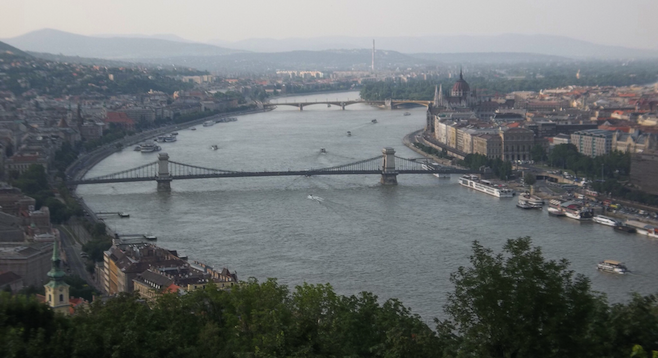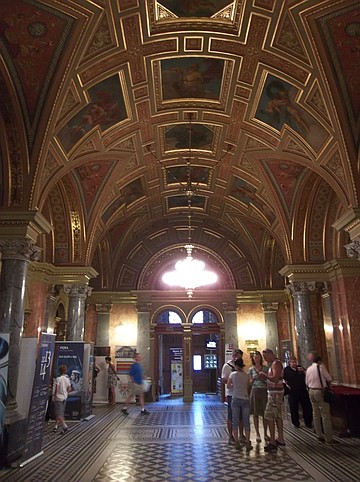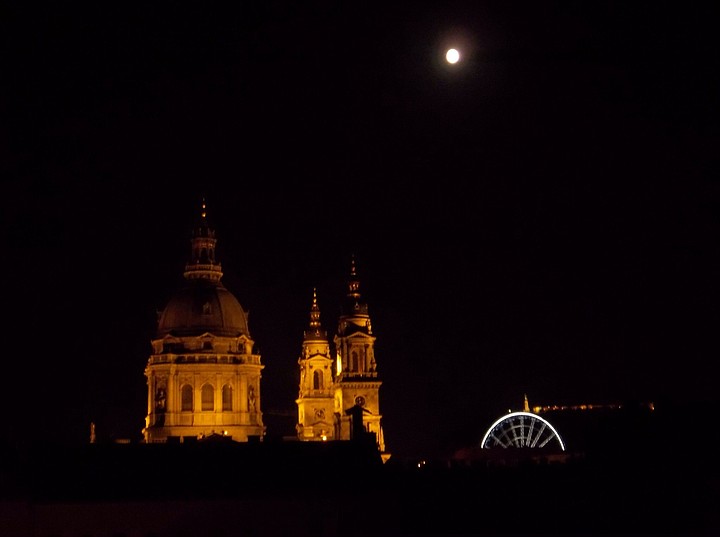 Facebook
Facebook
 X
X
 Instagram
Instagram
 TikTok
TikTok
 Youtube
Youtube


Few people are aware that Budapest is actually two cities, Buda and Pest, situated along the banks of the Danube River. Most visitors stay in Pest – it's got more to offer in terms of attractions and nightlife – but superior views are enjoyed from the Buda side of the river.
During a few scorching hot summer days, I stayed in Budapest (on the Pest side) with Julianna, an interpreter of English and Italian. We visited one of her favorite restaurants just off Andrassy Avenue, Budapest’s most fashionable street, lined with shops such as Gucci and Prada. I paused to admire the opulent Hungarian State Opera House, quite a spectacle at night. The next day, I poked around its lavish lobby (left) to admire the impressive design.
Julianna introduced me to some of her friends, including a couple who had once lived in New York. We had dinner on her balcony with a lovely view of the St. Stephen’s Basilica under a full moon as dusk slid into evening.

“Which Hungarian writer would you recommend that would give me some insight into the culture?” I asked.
“Marai. Sandor Marai.”
“Never heard of him.”
“He’s not well known in America, but he’s well regarded in Europe, especially in Hungary. He lived for a while in San Diego and committed suicide there.”
I researched Marai and confirmed that he indeed lived in San Diego at the end of his life in the '80s. He left Hungary in 1948 to escape the communist regime and lived in Italy for several years before moving to San Diego.
Marai’s books bleakly portray communism in Hungary and express nostalgia for the Austro-Hungarian Empire which was broken up after WWI, particularly in his most highly acclaimed novel, Embers. The Washington Post described Marai as “in the same league as Gabriel Garcia Marquez.”
Marai took his own life in 1989, less than a year, ironically, before the fall of the Berlin Wall and Soviet domination over Eastern Europe. Though publishing novels since the 1930s, Marai’s books were not translated into English until after his death in the 1990s.
Hungary values and celebrates its artists, writers and assorted military and political heroes with impressive memorials that immortalize them in the national conscience. Walk a few blocks nearly anywhere in Budapest, and you'll be captivated by the statues and sculptures that fill the town.
If you're interested in exploring the dark side of Budapest’s history, check out the House of Terror. The building on Andrassy Avenue was the former headquarters of the secret police of the Nazi and Communist governments. It’s hard to miss; the word TERROR is etched into the awning, underscoring the existential angst that hung over the city for much of the 20th century. Exhibits, photos and videos detail the occupation of Hungary by the Nazis and then the Communists along with the complicity of many locals. The basement has a particularly eerie atmosphere – it was the site of numerous tortures. The 1956 revolt against Soviet control was a seminal event in the nation’s history, and the struggle for freedom still evokes strong emotions among locals.
All the repression it experienced may have helped spur Budapest toward developing into a thriving center for the arts. Visitors have a wide variety of cultural activities and venues from which to choose. Some of the prime spots locally are the Budapest Opera House, the Museum of Fine Arts, the Palace of Arts, and the Academy of Music.
While the Hungarians have embraced freedom and the opportunities it provides, many have been left behind economically. The homeless population has grown in the past few years. As I sat with Julianna on her balcony patio discussing our lives, she expressed the economic anxiety she feels and bemoaned her paltry pension. “It would be laughable if it wasn’t so painful,” she confided in me.

Locals at least have the option of soaking away their troubles (and the heat) in the city’s dazzling medicinal public baths. One of the prime pleasures of a visit to Budapest is relaxing the muscles in the Széchenyi Baths in the city park. During my stay, the weather was unseasonably hot (hello, climate change) and the baths were a welcome respite. You'll pass by the impressive Heroes Square on a walk to the baths from Andrassy Avenue or the adjoining Metro.
The Gellert Baths on the Buda side of the Danube are another popular thermal complex. If you visit here, be sure to take in the panoramic view of the Danube slicing through Buda and Pest from nearby Gellert Hill (top).
No visit to Budapest would be complete without exploring some of the most spectacular interiors of any city. These include the Opera House, the basilica, Parliament, and New York Café. The latter is the most ornate and historically interesting of the many wonderful pastry and coffee houses throughout town. Gerbeaud’s Café is another popular spot to indulge in delectable pastries.
Grab a pastry, and board a boat for a night cruise down the Danube. Lay back, relax and ask yourself the question all visitors must face: To Buda or to Pest?
For more Budapest, check out our recent article on the city's ruin pubs.



Few people are aware that Budapest is actually two cities, Buda and Pest, situated along the banks of the Danube River. Most visitors stay in Pest – it's got more to offer in terms of attractions and nightlife – but superior views are enjoyed from the Buda side of the river.
During a few scorching hot summer days, I stayed in Budapest (on the Pest side) with Julianna, an interpreter of English and Italian. We visited one of her favorite restaurants just off Andrassy Avenue, Budapest’s most fashionable street, lined with shops such as Gucci and Prada. I paused to admire the opulent Hungarian State Opera House, quite a spectacle at night. The next day, I poked around its lavish lobby (left) to admire the impressive design.
Julianna introduced me to some of her friends, including a couple who had once lived in New York. We had dinner on her balcony with a lovely view of the St. Stephen’s Basilica under a full moon as dusk slid into evening.

“Which Hungarian writer would you recommend that would give me some insight into the culture?” I asked.
“Marai. Sandor Marai.”
“Never heard of him.”
“He’s not well known in America, but he’s well regarded in Europe, especially in Hungary. He lived for a while in San Diego and committed suicide there.”
I researched Marai and confirmed that he indeed lived in San Diego at the end of his life in the '80s. He left Hungary in 1948 to escape the communist regime and lived in Italy for several years before moving to San Diego.
Marai’s books bleakly portray communism in Hungary and express nostalgia for the Austro-Hungarian Empire which was broken up after WWI, particularly in his most highly acclaimed novel, Embers. The Washington Post described Marai as “in the same league as Gabriel Garcia Marquez.”
Marai took his own life in 1989, less than a year, ironically, before the fall of the Berlin Wall and Soviet domination over Eastern Europe. Though publishing novels since the 1930s, Marai’s books were not translated into English until after his death in the 1990s.
Hungary values and celebrates its artists, writers and assorted military and political heroes with impressive memorials that immortalize them in the national conscience. Walk a few blocks nearly anywhere in Budapest, and you'll be captivated by the statues and sculptures that fill the town.
If you're interested in exploring the dark side of Budapest’s history, check out the House of Terror. The building on Andrassy Avenue was the former headquarters of the secret police of the Nazi and Communist governments. It’s hard to miss; the word TERROR is etched into the awning, underscoring the existential angst that hung over the city for much of the 20th century. Exhibits, photos and videos detail the occupation of Hungary by the Nazis and then the Communists along with the complicity of many locals. The basement has a particularly eerie atmosphere – it was the site of numerous tortures. The 1956 revolt against Soviet control was a seminal event in the nation’s history, and the struggle for freedom still evokes strong emotions among locals.
All the repression it experienced may have helped spur Budapest toward developing into a thriving center for the arts. Visitors have a wide variety of cultural activities and venues from which to choose. Some of the prime spots locally are the Budapest Opera House, the Museum of Fine Arts, the Palace of Arts, and the Academy of Music.
While the Hungarians have embraced freedom and the opportunities it provides, many have been left behind economically. The homeless population has grown in the past few years. As I sat with Julianna on her balcony patio discussing our lives, she expressed the economic anxiety she feels and bemoaned her paltry pension. “It would be laughable if it wasn’t so painful,” she confided in me.

Locals at least have the option of soaking away their troubles (and the heat) in the city’s dazzling medicinal public baths. One of the prime pleasures of a visit to Budapest is relaxing the muscles in the Széchenyi Baths in the city park. During my stay, the weather was unseasonably hot (hello, climate change) and the baths were a welcome respite. You'll pass by the impressive Heroes Square on a walk to the baths from Andrassy Avenue or the adjoining Metro.
The Gellert Baths on the Buda side of the Danube are another popular thermal complex. If you visit here, be sure to take in the panoramic view of the Danube slicing through Buda and Pest from nearby Gellert Hill (top).
No visit to Budapest would be complete without exploring some of the most spectacular interiors of any city. These include the Opera House, the basilica, Parliament, and New York Café. The latter is the most ornate and historically interesting of the many wonderful pastry and coffee houses throughout town. Gerbeaud’s Café is another popular spot to indulge in delectable pastries.
Grab a pastry, and board a boat for a night cruise down the Danube. Lay back, relax and ask yourself the question all visitors must face: To Buda or to Pest?
For more Budapest, check out our recent article on the city's ruin pubs.
Comments